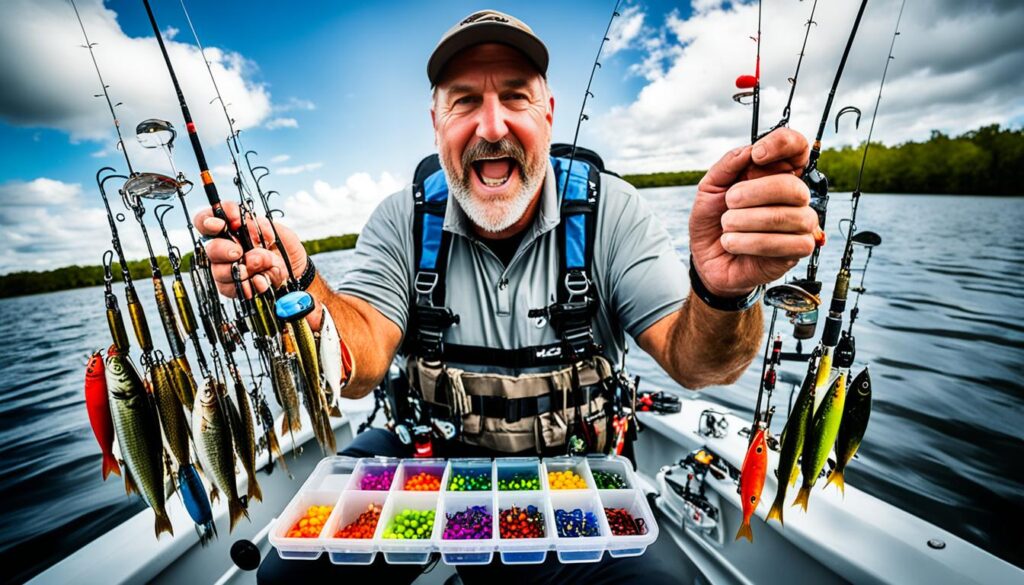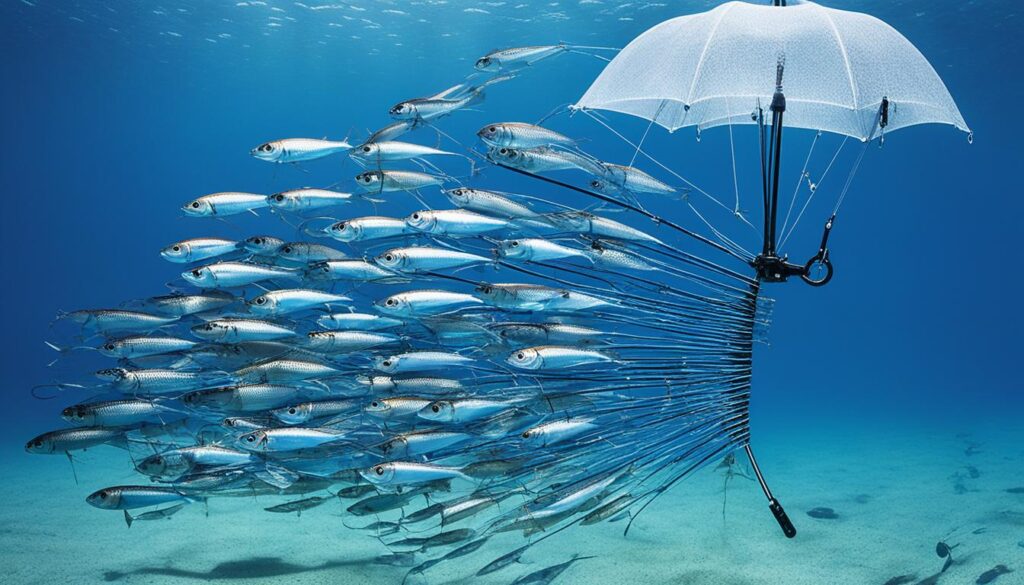If you’re a bass fishing enthusiast, you may have heard of the umbrella rig, also known as the A-Rig. But what exactly is it, and how does it work? The umbrella rig is a fishing rig that consists of wires, blades, hooks, and dummy baits. It is designed to imitate a school of baitfish swimming through the water, which can attract bass from a distance.
The umbrella rig gained popularity in 2011 and has become a go-to technique for many anglers looking to catch big bass. Why? It’s particularly effective during the cold water months when bass are more sluggish and less likely to chase down individual baits. With an umbrella rig, you can present multiple lures simultaneously, increasing your chances of enticing a strike.
Key Takeaways:
- The umbrella rig is a fishing rig that imitates a school of baitfish and is effective for catching bass.
- It gained popularity in 2011 and is particularly effective during the cold water months.
- The rig consists of wires, blades, hooks, and dummy baits.
- It can be fished in various locations, such as around docks, bluff walls, open water, and over grass.
- Using the proper setup and varying your retrieve speed can increase your chances of success.
How To Set Up An Umbrella Rig
Setting up an umbrella rig may seem intimidating initially, but it can be broken down into simple steps. Following these guidelines will allow you to hit the water and start reeling in the bass with your perfectly configured rig.
Choosing the Right Wire Size
Regarding wire size, it’s essential to consider water clarity. In crystal clear water, opt for thinner wire as it will be harder for fish to spot. This allows for more natural movement of the rig, increasing its effectiveness.
Shaping the Umbrella Rig
To create an effective umbrella rig, follow these recommended steps:
- Position two small dummy baits on top of the rig.
- Place a larger bait in the middle, connected to a slightly longer wire.
- Attach two medium-sized baits on either side of the larger bait.
To achieve a more natural look, use an Owner Center Pin Spring to attach the dummy baits. This eliminates the need for hooks and presents a more enticing presentation to bass.
Setting Up the Hooks
Attach the hooks horizontally using jig heads like the Golden Eye Swimmer Head from Outkast Tackle. This configuration optimizes the rig’s performance and enhances the presentation of the baits.
Adding Extra Distinction
A small but effective trick is to dye or color the tail and head of the giant bait. This added distinction can attract the attention of the bass and increase the likelihood of triggering strikes.
With these simple steps, you’ll be ready to set up your umbrella rig and start enticing bass with its realistic presentation. Please remember to experiment with different bait combinations and adjust your setup according to water conditions for the best results.
Where to Fish the Umbrella Rig

The umbrella rig offers excellent versatility when it comes to fishing locations. Whether you’re targeting smallmouth or largemouth bass, there are several key areas where the umbrella rig can be effective. Here are the best places for fishing the umbrella rig:
- Around Docks: Docks provide a perfect structure and cover for bass, making them a prime location for using the umbrella rig. You can make your rig close to the docks and let it swim through the water, imitating a school of baitfish.
- Bluff Walls: Bass often position themselves near bluff walls, waiting to ambush passing prey. By fishing the umbrella rig along these walls, you increase your chances of catching bass that are actively feeding.
- In Open Water: Open water areas like points and flats can also be productive for umbrella rig fishing. Look for signs of baitfish activity, such as jumping shad or bird activity, as these are indications that bass are feeding in the area.
- Over Grass: Bass love to lurk in and around grass beds and the umbrella rig can effectively target them. Cast your rig over the grass and work it through the vegetation, mimicking the movement of a school of baitfish.
When choosing where to fish the umbrella rig, it’s essential to consider the water clarity and the bass’s feeding preferences. A more subtle presentation is often needed to entice bites in clearer and calmer water. On the other hand, in wind or stained water, bladed versions of the umbrella rig can attract bass with their vibration and flash. Please watch for areas where bass feed on shad or other baitfish, as these locations will likely produce the best results.
Remember to always check and comply with the fishing laws and regulations regarding using the umbrella rig in your state. This ensures you are fishing ethically and sustainably while avoiding potential fines or penalties.
| Fishing Location | Advantages | Disadvantages |
|---|---|---|
| Around Docks | – Provides structure and cover for bass – Bass waiting to ambush passing prey |
– Potential for snagging on dock structures |
| Bluff Walls | – Bass position themselves near bluff walls – Increased chances of catching actively feeding bass |
– Requires careful boat positioning and casting accuracy |
| In Open Water | – Look for signs of baitfish activity – Bass feeding on baitfish |
– Requires locating active feeding areas |
| Over Grass | – Bass lurking in and around grass beds – Mimics the movement of a school of baitfish |
– Potential for snagging in dense vegetation |
Gear Needed to Fish the Umbrella Rig
When fishing with an umbrella rig, using the right gear is essential to maximize your chances of success. Here are the recommended fishing gear for umbrella rig enthusiasts:
Rod
The ideal rod length for fishing with an umbrella rig is 7 ½ to 8 feet. Opt for a rod with heavy or extra-heavy power to handle the weight and ensure proper control. Popular options among anglers include:
- St. Croix Mojo Bass Casting Rod
- Lew’s Mach Crush Speed Stick Casting Rod
- Abu Garcia Villain 2.0 Casting Rod
Reel
Pair your umbrella rig rod with a heavy-duty baitcasting reel to handle the fishing demands of this rig. Look for a low gear ratio reel, such as 5.4:1, to provide the necessary power and control. Here are some recommended options:
- Shimano Curado DC Baitcasting Reel
- Lew’s Tournament Pro LFS Baitcasting Reel
- Abu Garcia Ambassadeur C4 Baitcasting Reel
Line
Choosing the right line is crucial when fishing with an umbrella rig. The two main options are braided line and fluorocarbon, each with its advantages:
- Braided Line: Offers excellent strength, sensitivity, and castability. The lack of stretch allows for better hooksets. Recommended choices:
- Power Pro Spectra Fiber Braided Fishing Line (50-pound test)
- Berkley FireLine Superline Fishing Line (50-pound test)
- Suffix 832 Advanced Superline Braid Fishing Line (50-pound test)
- Fluorocarbon Line: Provides excellent invisibility underwater and is preferred for fishing in clear water conditions. Recommended choices:
- Seaguar AbrazX Fluorocarbon Fishing Line (20-pound test)
- Berkley Vanish fluorocarbon Fishing Line (20-pound test)
- P-Line Floroclear Fluorocarbon Coated Fishing Line (20-pound test)
Investing in the right gear – a high-quality rod, heavy-duty baitcasting reel, and the appropriate line – you’ll be well-equipped to fish with an umbrella rig and increase your chances of landing that trophy bass.
You can incorporate this gear into your fishing arsenal,/’ and let’s dive into some expert tips on how to fish the umbrella rig effectively.
Tips for Fishing with an Umbrella Rig

When fishing with an umbrella rig, there are several tips to remember. By following these tips, you can enhance your chances of success and make the most of this effective fishing technique.
Vary Your Retrieve Speed and Rod Angle
To mimic the natural movement of a school of baitfish, it’s crucial to vary your retrieve speed and rod angle. Experiment with different speeds, from slow to fast, to find what triggers more strikes from bass. Additionally, adjusting the rod angle can create a more realistic presentation.Could you try holding the rod tip high or low and observe how it affects the movement of the umbrella rig?
Mix Up the Retrieve with Twitches and Pops
Adding twitches or pops to your retrieve can entice followers to turn into strikes. These sudden movements can mimic injured or fleeing baitfish, which bass find irresistible.Could you incorporate occasional twitching or popping actions into your retrieve to trigger aggressive responses from the bass?
Have Realistic Expectations
While the umbrella rig is a powerful tool, it’s essential to have realistic expectations. Understand that it’s not a guaranteed “cure-all” for catching bass in all situations. The effectiveness of the umbrella rig varies depending on factors such as water conditions, bass behavior, and baitfish presence. It is most effective when bass feed on shad and during the cold-water seasons. Setting realistic expectations allows you to appreciate the successes and challenges of fishing the umbrella rig.
Practice and Adapt
Like any fishing technique, mastering the umbrella rig requires practice and adaptability. I’d like you to please take the time to familiarize yourself with the rig’s movements and how different retrieves affect its presentation. Experiment with various bait combinations, blade styles, and wire setups to find the best for your fishing conditions. The more you practice, the more confident and effective you’ll become with the umbrella rig.
Stay Up-to-Date on Fishing Regulations
It’s crucial to stay updated on the fishing laws and regulations regarding using the umbrella rig in your state. Some states restrict the number of hooks on the rig or may require additional licenses or permits. By adhering to these regulations, you ensure ethical fishing practices and contribute to the preservation of fisheries for future anglers.
| Tips for Fishing with an Umbrella Rig |
|---|
| Vary your retrieve speed and rod angle |
| Mix up the retrieve with twitches and pops |
| Have realistic expectations |
| Practice and adapt |
| Stay up-to-date on fishing regulations |
Conclusion
The umbrella rig is a versatile fishing rig that has proven highly effective in imitating a school of baitfish and attracting bass from afar. Particularly effective during the cold-water months and when bass feed on shad or other baitfish, the umbrella rig offers anglers a valuable technique for increasing their chances of success.
To maximize results with the umbrella rig, it is crucial to use the appropriate setup, vary the retrieve speed, and strategically choose fishing locations. Anglers can optimize their rig’s performance by investing in a medium to heavy power rod, a heavy-duty baitcasting reel, and the right line strength. Additionally, varying the retrieve speed and experimenting with different bait combinations can help trigger strikes from bass.
While the umbrella rig is a powerful fishing tool, it is important to maintain realistic expectations. It’s only a guaranteed solution for catching bass in some situations. However, with practice and experience, anglers can unlock the secrets of bass fishing with an umbrella rig, making it a valuable addition to their fishing arsenal. Following fishing laws and regulations is crucial to ensure ethical angling practices and conserve fish populations for future generations.
In conclusion, the umbrella rig allows anglers to enhance their bass fishing technique and increase their catch. With the right approach, patience, and a commitment to ethical fishing, anglers can enjoy the excitement and success of using this versatile rig.
FAQ
What is an umbrella rig for bass fishing?
An umbrella rig, also known as the A-Rig, is a fishing rig that imitates a school of baitfish. It consists of wires, blades, hooks, and dummy baits.
How do you set up an umbrella rig?
To set up an umbrella rig, choose the wire size based on water clarity and shape the rig with dummy baits on top, a larger bait in the middle, and medium-sized baits on the sides. Attach the dummy baits using an Owner Center Pin Spring and the baits with hooks horizontally using jig heads.
Where can I fish the umbrella rig?
The umbrella rig can be fished in various locations, including around docks, bluff walls, open water, and over grass. It is effective in smallmouth and largemouth lakes, imitating different types of baitfish.
What gear do I need to fish the umbrella rig?
An ideal setup for fishing with the umbrella rig includes a medium to heavy power rod, a heavy-duty baitcasting reel, and a 20-pound fluorocarbon or 50-pound braided line.
What are some tips for fishing with an umbrella rig?
Tips for fishing with an umbrella rig include varying the retrieve speed and rod angle, mixing up the retrieve with twitches or pops, and having realistic expectations. Following fishing laws and regulations regarding the number of hooks allowed on the rig is also important.
Is the umbrella rig a guaranteed solution for catching bass?
No, the umbrella rig is not a guaranteed solution for catching bass. It is most effective during the cold-water seasons and when bass feed on shad or other baitfish. Practice and experience are vital to mastering the rig.
What are the best locations for fishing the umbrella rig?
The umbrella rig is effective around docks, bluff walls, open water, and over grass. It can be used in smallmouth and largemouth lakes, targeting areas where bass feed on shad or other baitfish.
What is the recommended gear for fishing with the umbrella rig?
The recommended gear for fishing with the umbrella rig includes a 7 ½ to 8-foot rod with heavy or extra-heavy power, a heavy-duty baitcasting reel with a low gear ratio, and either a 50-pound braided line or a 20-pound fluorocarbon.
How effective is the umbrella rig for bass fishing?
The umbrella rig is a versatile fishing rig that can effectively imitate a school of baitfish and attract bass from a distance. It is particularly effective during the cold-water months and when bass feed on shad or other baitfish.
Are there any tips for fishing with the umbrella rig?
Some tips for fishing with the umbrella rig include varying the retrieve speed and rod angle, mixing up the retrieve with twitches or pops, and having realistic expectations. I would also like you to follow fishing laws and regulations regarding using the umbrella rig in your state.
Can the umbrella rig be used in both smallmouth and largemouth lakes?
Yes, the umbrella rig can be used in both smallmouth and largemouth lakes. It imitates a school of baitfish, not just shad, making it effective in various bodies of water.
